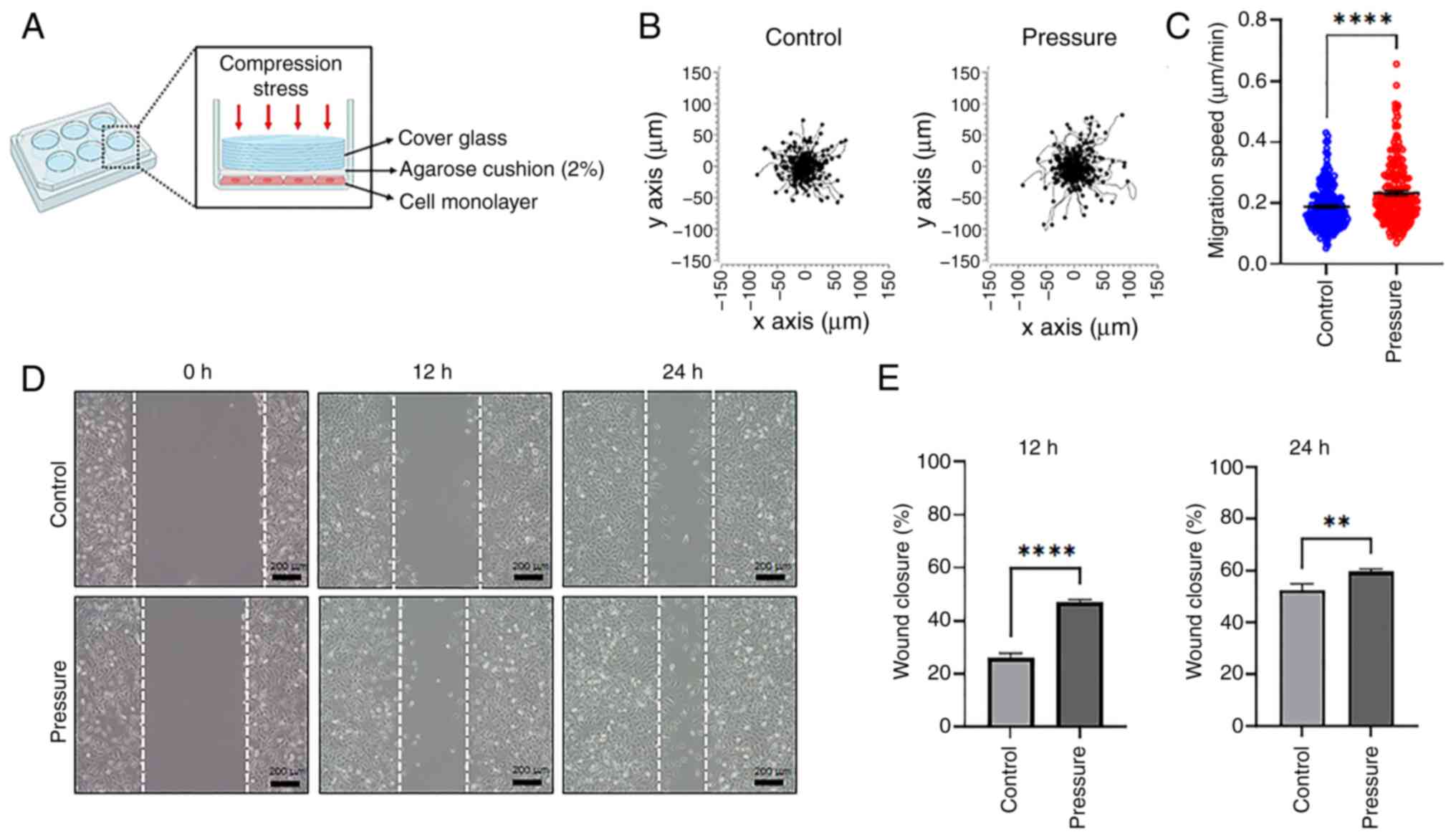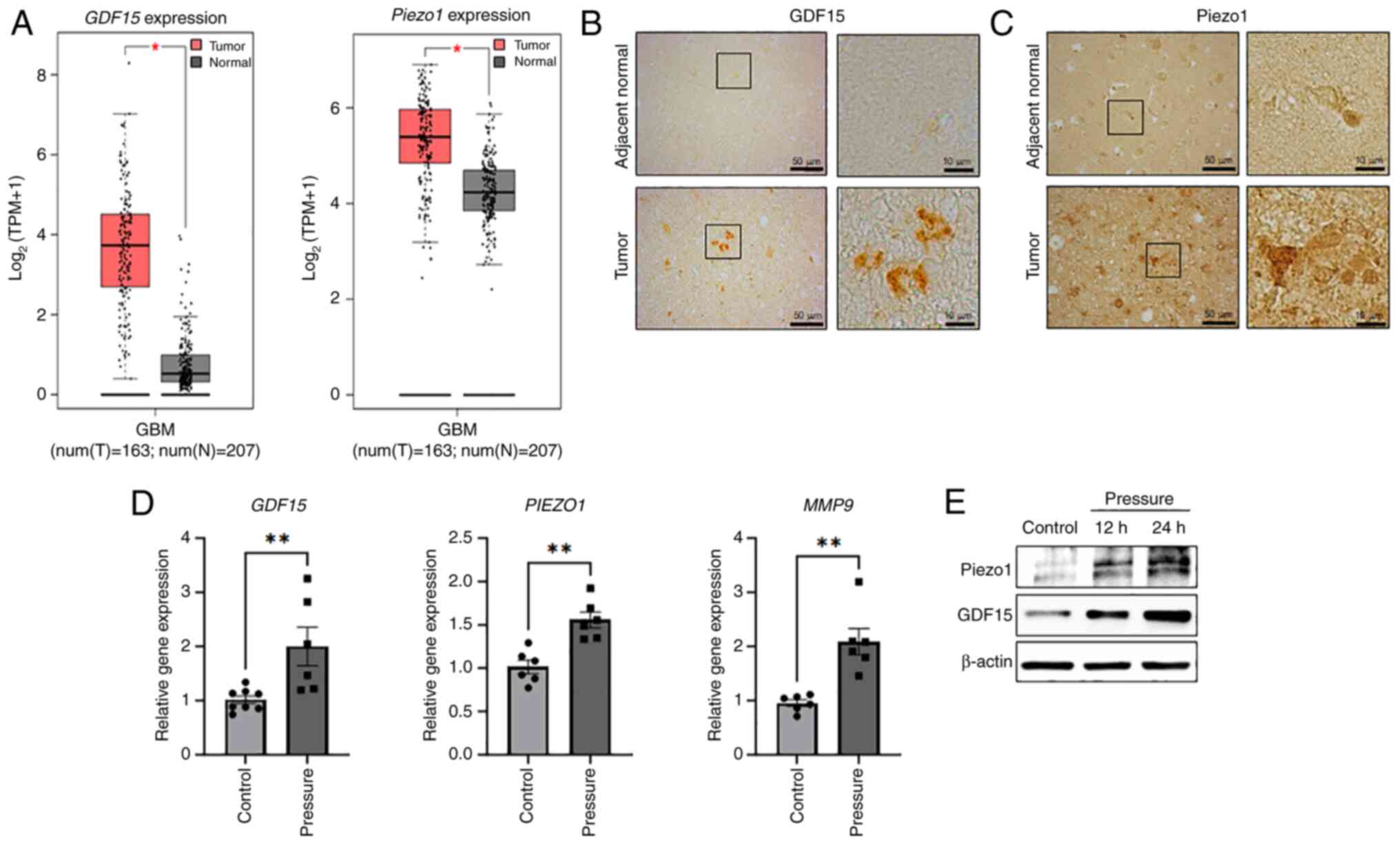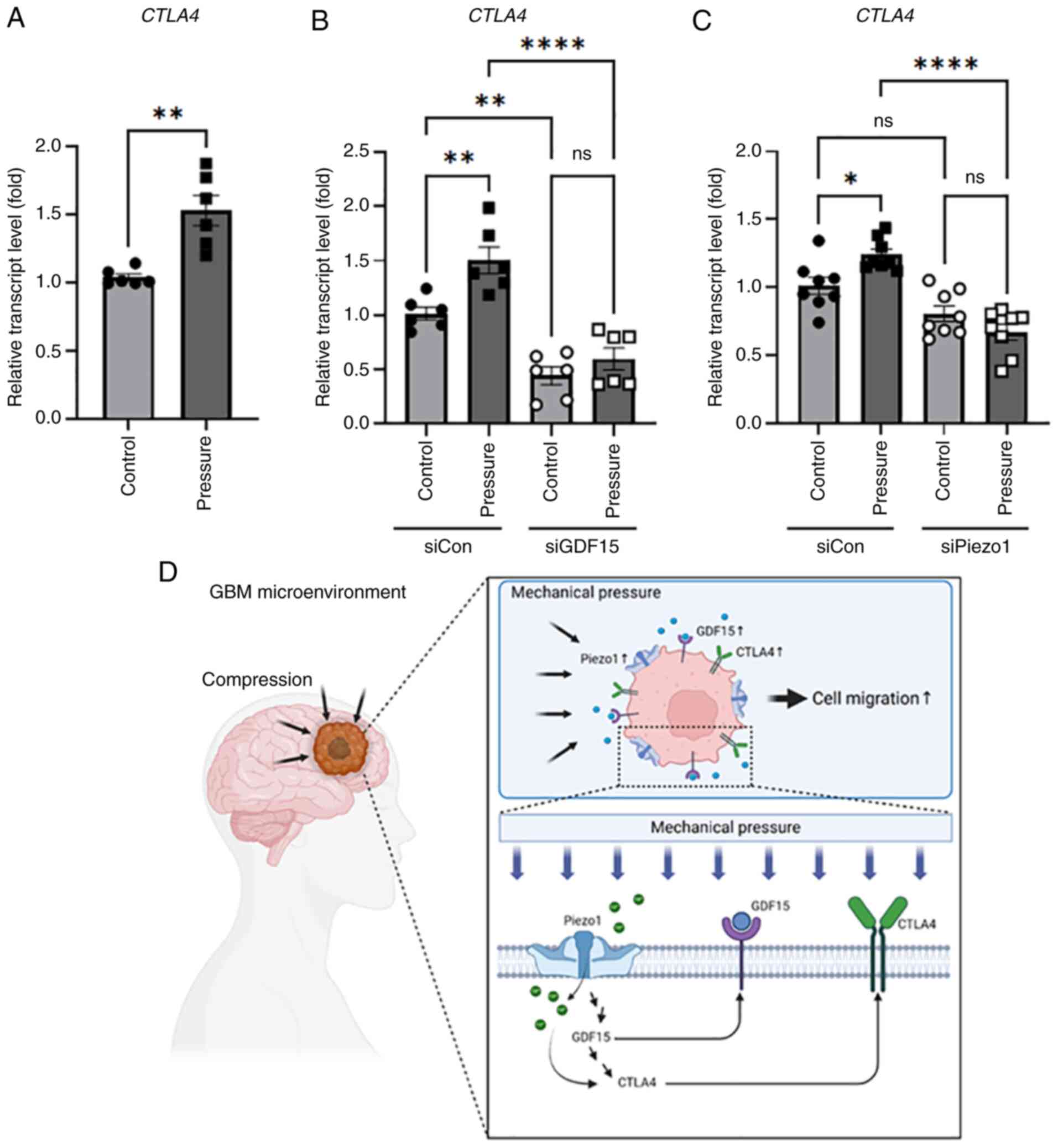|
1
|
Ostrom QT, Bauchet L, Davis FG, Deltour I,
Fisher JL, Langer CE, Pekmezci M, Schwartzbaum JA, Turner MC, Walsh
KM, et al: The epidemiology of glioma in adults: A ‘state of the
science’ review. Neuro Oncol. 16:896–913. 2014. View Article : Google Scholar : PubMed/NCBI
|
|
2
|
Lin D, Wang M, Chen Y, Gong J, Chen L, Shi
X, Lan F, Chen Z, Xiong T, Sun H and Wan S: Trends in intracranial
glioma incidence and mortality in the United States, 1975–2018.
Front Oncol. 11:7480612021. View Article : Google Scholar : PubMed/NCBI
|
|
3
|
Yeo AT and Charest A: Immune checkpoint
blockade biology in mouse models of glioblastom. J Cell Biochem.
118:2516–2527. 2017. View Article : Google Scholar : PubMed/NCBI
|
|
4
|
Bausart M, Préat V and Malfanti A:
Immunotherapy for glioblastoma: The promise of combination
strategies. J Exp Clin Cancer Res. 41:352022. View Article : Google Scholar : PubMed/NCBI
|
|
5
|
Parry RV, Chemnitz JM, Frauwirth KA,
Lanfranco AR, Braunstein I, Kobayashi SV, Linsley PS, Thompson CB
and Riley JL: CTLA-4 and PD-1 receptors inhibit T-cell activation
by distinct mechanisms. Mol Cell Biol. 25:9543–9553. 2005.
View Article : Google Scholar : PubMed/NCBI
|
|
6
|
Wintterle S, Schreiner B, Mitsdoerffer M,
Schneider D, Chen L, Meyermann R, Weller M and Wiendl H: Expression
of the B7-related molecule B7-H1 by glioma cells: A potential
mechanism of immune paralysis. Cancer Res. 63:7462–7467.
2003.PubMed/NCBI
|
|
7
|
Seano G, Nia HT, Emblem KE, Datta M, Ren
J, Krishnan S, Kloepper J, Pinho MC, Ho WW, Ghosh M, et al: Solid
stress in brain tumours causes neuronal loss and neurological
dysfunction and can be reversed by lithium. Nat Biomed Eng.
3:230–245. 2019. View Article : Google Scholar : PubMed/NCBI
|
|
8
|
Gamburg ES, Regine WF, Patchell RA,
Strottmann JM, Mohiuddin M and Young AB: The prognostic
significance of midline shift at presentation on survival in
patients with glioblastoma multiforme. Int J Radiat Oncol Biol
Phys. 48:1359–1362. 2000. View Article : Google Scholar : PubMed/NCBI
|
|
9
|
Kreth FW, Berlis A, Spiropoulou V, Faist
M, Scheremet R, Rossner R, Volk B and Ostertag CB: The role of
tumor resection in the treatment of glioblastoma multiforme in
adults. Cancer. 86:2117–2123. 1999. View Article : Google Scholar : PubMed/NCBI
|
|
10
|
Cheng G, Tse J, Jain RK and Munn LL:
Micro-environmental mechanical stress controls tumor spheroid size
and morphology by suppressing proliferation and inducing apoptosis
in cancer cells. PLoS One. 4:e46322009. View Article : Google Scholar : PubMed/NCBI
|
|
11
|
Paul CD, Mistriotis P and Konstantopoulos
K: Cancer cell motility: Lessons from migration in confined spaces.
Nat Rev Cancer. 17:131–140. 2017. View Article : Google Scholar : PubMed/NCBI
|
|
12
|
Tse JM, Cheng G, Tyrrell JA,
Wilcox-Adelman SA, Boucher Y, Jain RK and Munn LL: Mechanical
compression drives cancer cells toward invasive phenotype. Proc
Natl Acad Sci USA. 109:911–916. 2012. View Article : Google Scholar : PubMed/NCBI
|
|
13
|
Grossen A, Smith K, Coulibaly N, Arbuckle
B, Evans A, Wilhelm S, Jones K, Dunn I, Towner R, Wu D, et al:
Physical forces in glioblastoma migration: A systematic review. Int
J Mol Sci. 23:40552022. View Article : Google Scholar : PubMed/NCBI
|
|
14
|
Calhoun MA, Cui Y, Elliott EE, Mo X, Otero
JJ and Winter JO: MicroRNA-mRNA interactions at low levels of
compressive solid stress implicate mir-548 in increased
glioblastoma cell motility. Sci Rep. 10:3112020. View Article : Google Scholar : PubMed/NCBI
|
|
15
|
Kim JW, Lee KS, Nahm JH and Kang YG:
Effects of compressive stress on the expression of M-CSF, IL-1β,
RANKL and OPG mRNA in periodontal ligament cells. Korean J Orthod.
39:248–256. 2009. View Article : Google Scholar
|
|
16
|
Kalli M, Papageorgis P, Gkretsi V and
Stylianopoulos T: Solid stress facilitates fibroblasts activation
to promote pancreatic cancer cell migration. Ann Biomed Eng.
46:657–669. 2018. View Article : Google Scholar : PubMed/NCBI
|
|
17
|
Chen YC, Fu YS, Tsai SW, Wu PK, Chen CM,
Chen WM and Chen CF: IL-1b in the secretomes of MSCs seeded on
human decellularized allogeneic bone promotes angiogenesis. Int J
Mol Sci. 23:153012022. View Article : Google Scholar : PubMed/NCBI
|
|
18
|
Livak K and Schmittgen TD: Analysis of
relative gene expression data using real-time quantitative PCR and
the 2(−Delta Delta C(T)) method. Methods. 25:402–408. 2001.
View Article : Google Scholar : PubMed/NCBI
|
|
19
|
Kim OH, Choi YW, Park JH, Hong SA, Hong M,
Chang IH and Lee HJ: Fluid shear stress facilitates prostate cancer
metastasis through Piezo1-Src-YAP axis. Life Sci. 308:1209362022.
View Article : Google Scholar : PubMed/NCBI
|
|
20
|
Ranade SS, Qiu Z, Woo SH, Hur SS, Murthy
SE, Cahalan SM, Xu J, Mathur J, Bandell M, Coste B, et al: Piezo1,
a mechanically activated ion channel, is required for vascular
development in mice. Proc Natl Acad Sci USA. 111:10347–10352. 2014.
View Article : Google Scholar : PubMed/NCBI
|
|
21
|
Liu F, Huang J, Liu X, Cheng Q, Luo C and
Liu Z: CTLA-4 correlates with immune and clinical characteristics
of glioma. Cancer Cell Int. 20:72020. View Article : Google Scholar : PubMed/NCBI
|
|
22
|
Gilkes DM and Wirtz D: Tumour
mechanopathology: Cutting the stress out. Nat Biomed Eng.
1:00122017. View Article : Google Scholar : PubMed/NCBI
|
|
23
|
Kalli M and Stylianopoulos T: Defining the
role of solid stress and matrix stiffness in cancer cell
proliferation and metastasis. Front Oncol. 8:552018. View Article : Google Scholar : PubMed/NCBI
|
|
24
|
Guaccio A, Borselli C, Oliviero O and
Netti PA: Oxygen consumption of chondrocytes in agarose and
collagen gels: Acomparative analysis. Biomaterials. 29:1484–1493.
2008. View Article : Google Scholar : PubMed/NCBI
|
|
25
|
Kalli M, Voutouri C, Minia A, Pliaka V,
Fotis C, Alexopoulos LG and Stylianopoulos T: Mechanical
compression regulates brain cancer cell migration through MEK1/Erk1
pathway activation and GDF15 expression. Front Oncol. 9:9922019.
View Article : Google Scholar : PubMed/NCBI
|
|
26
|
Piek J, Plewe P and Bock WJ:
Intrahemispheric gradients of brain tissue pressure in patients
with brain tumours. Acta Neurochir (Wien). 93:129–132. 1988.
View Article : Google Scholar : PubMed/NCBI
|
|
27
|
Helmlinger G, Netti PA, Lichtenbeld HC,
Melder RJ and Jain RK: Solid stress inhibits the growth of
multicellular tumor spheroids. Nat Biotechnol. 15:778–783. 1997.
View Article : Google Scholar : PubMed/NCBI
|
|
28
|
Stylianopoulos T, Martin JD, Chauhan VP,
Jain SR, Diop-Frimpong B, Bardeesy N, Smith BL, Ferrone CR,
Hornicek FJ, Boucher Y, et al: Causes, consequences, and remedies
for growth-induced solid stress in murine and human tumors. Proc
Natl Acad Sci USA. 109:15101–15108. 2012. View Article : Google Scholar : PubMed/NCBI
|
|
29
|
Coste B, Mathur J, Schmidt M, Earley TJ,
Ranade S, Petrus MJ, Dubin AE and Patapoutian A: Piezo1 and Piezo2
are essential components of distinct mechanically activated cation
channels. Science. 330:55–60. 2010. View Article : Google Scholar : PubMed/NCBI
|
|
30
|
Brohawn SG, Campbell EB and MacKinnon R:
Physical mechanism for gating and mechanosensitivity of the human
TRAAK K+ channel. Nature. 516:126–130. 2014. View Article : Google Scholar : PubMed/NCBI
|
|
31
|
Lee W, Leddy HA, Chen Y, Lee SH, Zelenski
NA, McNulty AL, Wu J, Beicker KN, Coles J, Zauscher S, et al:
Synergy between Piezo1 and Piezo2 channels confers high-strain
mechanosensitivity to articular cartilage. Proc Natl Acad Sci USA.
111:E5114–E5122. 2014. View Article : Google Scholar : PubMed/NCBI
|
|
32
|
Li J, Hou B, Tumova S, Muraki K, Bruns A,
Ludlow MJ, Sedo A, Hyman AJ, McKeown L, Young RS, et al: Piezo1
integration of vascular architecture with physiological force.
Nature. 515:279–282. 2014. View Article : Google Scholar : PubMed/NCBI
|
|
33
|
Miyamoto T, Mochizuki T, Nakagomi H, Kira
S, Watanabe M, Takayama Y, Suzuki Y, Koizumi S, Takeda M and
Tominaga M: Functional role for Piezo1 in stretch-evoked
Ca2+ influx and ATP release in urothelial cell cultures.
J Biol Chem. 289:16565–16575. 2014. View Article : Google Scholar : PubMed/NCBI
|
|
34
|
Chen X, Wanggou S, Bodalia A, Zhu M, Dong
W, Fan JJ, Yin WC, Min HK, Hu M, Draghici D, et al: A feedforward
mechanism mediated by mechanosensitive ion channel PIEZO1 and
tissue mechanics promotes glioma aggression. Neuron.
100:799–815.e7. 2018. View Article : Google Scholar : PubMed/NCBI
|
|
35
|
Cekanova M, Lee SH, Donnell RL,
Sukhthankar M, Eling TE, Fischer SM and Baek SJ: Nonsteroidal
anti-inflammatory drug-activated gene-1 expression inhibits
urethane-induced pulmonary tumorigenesis in transgenic mice. Cancer
Prev Res (Phila). 2:450–458. 2009. View Article : Google Scholar : PubMed/NCBI
|
|
36
|
Husaini Y, Qiu MR, Lockwood GP, Luo XW,
Shang P, Kuffner T, Tsai VW, Jiang L, Russell PJ, Brown DA and
Breit SN: Macrophage inhibitory cytokine-1 (MIC-1/GDF15) slows
cancer development but increases metastases in TRAMP prostate
cancer prone mice. PLoS One. 7:e438332012. View Article : Google Scholar : PubMed/NCBI
|
|
37
|
Li S, Ma YM, Zheng PS and Zhang P: GDF15
promotes the proliferation of cervical cancer cells by
phosphorylating AKT1 and Erk1/2 through the receptor ErbB2. J Exp
Clin Cancer Res. 37:802018. View Article : Google Scholar : PubMed/NCBI
|
|
38
|
Vaňhara P, Hampl A, Kozubík A and Souček
K: Growth/differentiation factor-15: Prostate cancer suppressor or
promoter? Prostate Cancer Prostatic Dis. 15:320–328. 2012.
View Article : Google Scholar : PubMed/NCBI
|
|
39
|
Roth P, Junker M, Tritschler I,
Mittelbronn M, Dombrowski Y, Breit SN, Tabatabai G, Wick W, Weller
M and Wischhusen J: GDF-15 contributes to proliferation and immune
escape of malignant gliomas. Clin Cancer Res. 16:3851–3859. 2010.
View Article : Google Scholar : PubMed/NCBI
|
|
40
|
Shnaper S, Desbaillets I, Brown DA, Murat
A, Migliavacca E, Schluep M, Ostermann S, Hamou MF, Stupp R, Breit
SN, et al: Elevated levels of MIC-1/GDF15 in the cerebrospinal
fluid of patients are associated with glioblastoma and worse
outcome. Int J Cancer. 125:2624–2630. 2009. View Article : Google Scholar : PubMed/NCBI
|
|
41
|
Laurent S, Queirolo P, Boero S, Salvi S,
Piccioli P, Boccardo S, Minghelli S, Morabito A, Fontana V, Pietra
G, et al: The engagement of CTLA-4 on primary melanoma cell lines
induces antibody-dependent cellular cytotoxicity and TNF-α
production. J Transl Med. 11:1082013. View Article : Google Scholar : PubMed/NCBI
|
|
42
|
Pistillo MP, Carosio R, Grillo F, Fontana
V, Mastracci L, Morabito A, Banelli B, Tanda E, Cecchi F, Dozin B,
et al: Phenotypic characterization of tumor CTLA-4 expression in
melanoma tissues and its possible role in clinical response to
Ipilimumab. Clin Immunol. 215:1084282020. View Article : Google Scholar : PubMed/NCBI
|
|
43
|
Zhang H, Dai Z, Wu W, Wang Z, Zhang N,
Zhang L, Zeng WJ, Liu Z and Cheng Q: Regulatory mechanisms of
immune checkpoints PD-L1 and CTLA-4 in cancer. J Exp Clin Cancer
Res. 40:1842021. View Article : Google Scholar : PubMed/NCBI
|
|
44
|
Linsley PS, Bradshaw J, Greene J, Peach R,
Bennett KL and Mittler RS: Intracellular trafficking of CTLA-4 and
focal localization towards sites of TCR engagement. Immunity.
4:535–543. 1996. View Article : Google Scholar : PubMed/NCBI
|













